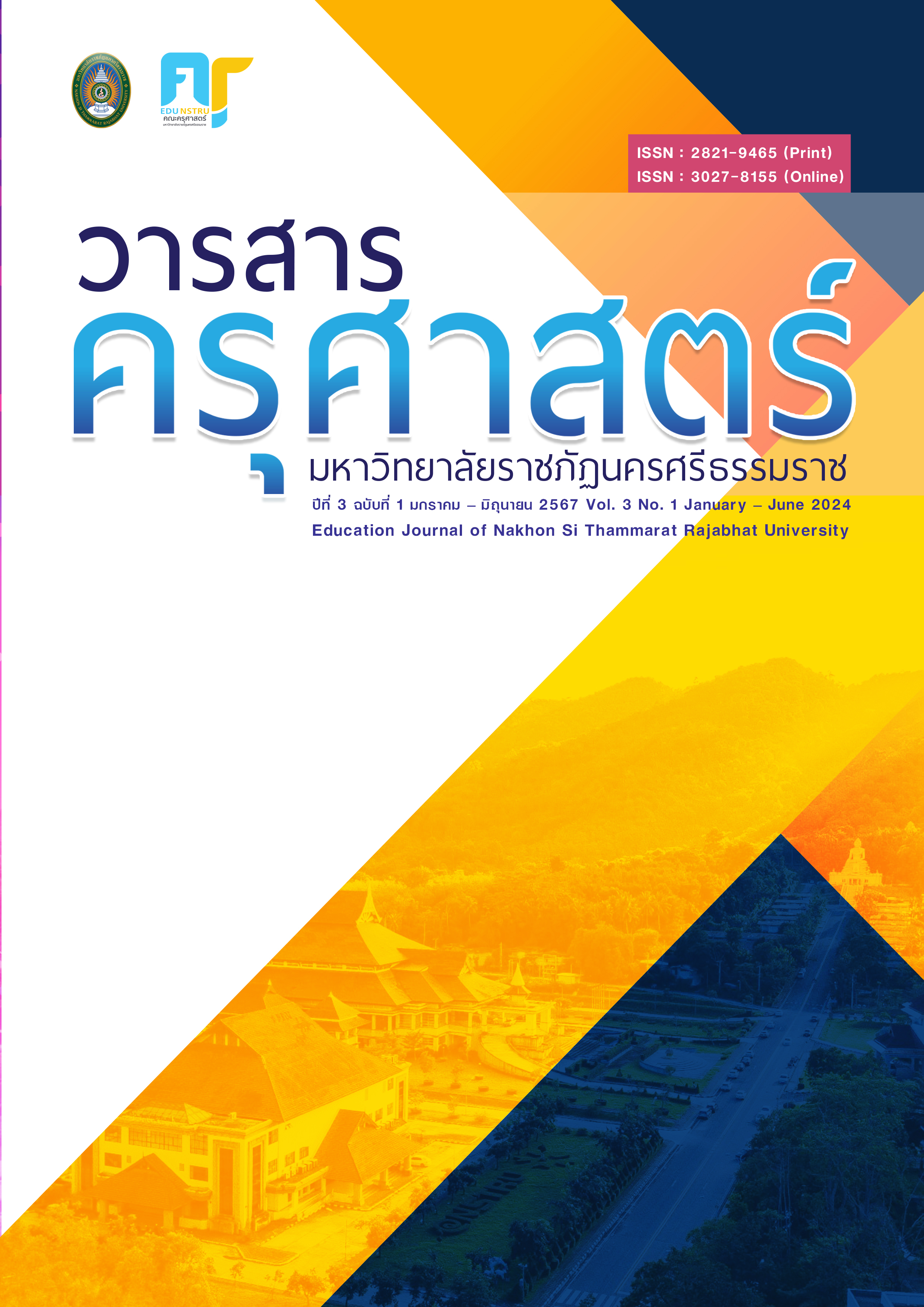A Sufficiency-Based School Administration Model Towards Learning Centers In Accordance with the Philosophy of Sufficiency Economy in Education of Schools Under the Trang Primary Educational Service Area Office 2
Main Article Content
Abstract
This research aimed to 1) study the current conditions and components of the administration of sufficiency-based schools under the Trang Primary Educational Service Area Office Two, 2) develop a sufficiency-based school administration model towards learning centers in accordance with the philosophy of sufficiency economy in education, and 3) evaluate the constructed model. A mixed-methods research approach was employed. 1) In the quantitative research, was conducted using a questionnaire to collect data from 88 schools. Employing multi-stage and simple random sampling by drawing lots. A total of 264 key informants were selected using purposive sampling. Using percentage (%), mean (M), and standard deviation (S.D.). 2) In the qualitative research, (1) a model was constructed and inspected using a model checklist to ensure accuracy and suitability. (2) The model was evaluated using an evaluation form to assess accuracy, suitability, feasibility, and usability.
Findings: 1) The current conditions of sufficiency-based school administration showed overall performance at the highest level (=4.22, S.D.=0.75). Similarly, the conditions towards learning centers were at the highest level ( =4.23, S.D.=0.69). The model consisted of two main components: (1) excellence enhancement, with seven major components and eight supporting components, and (2) development level, with six major components and nine supporting factors. 2) The sufficiency-based school administration model towards learning centers included four parts: (1) introduction (the model title, concepts and principles, objectives, strategies/guidelines, goals) (2) model characteristics (3) implementation steps (4) factors/conditions for success.and3) Evaluation Results are 100% accuracy, with 97.22 % suitability, feasibility, usability.
Article Details

This work is licensed under a Creative Commons Attribution-NonCommercial-NoDerivatives 4.0 International License.
บทความที่ได้รับการตีพิมพ์เป็นลิขสิทธิ์ของวารสารครุศาตร์ มหาวิทยาลัยราชภัฏนครศรีธรราช
ข้อความที่ปรากฏในบทความแต่ละเรื่องในวารสารวิชาการเล่มนี้เป็นความคิดเห็นส่วนตัวของผู้เขียนแต่ละท่านไม่เกี่ยวข้องกับวารสารครุศาสตร์ มหาวิทยาลัยราชภัฏนครศรีธรรมราช
References
Autchobkarn, S., Sawpayon, S., & Songkitipisal, M. (2023). An Administration Model for Basic Education Institutions under the Office of the Basic Education Commission Affecting Competency Development of Learners in the Era of Thailand 4.0. Journal of MCU Peace Studies, 11(6), 2179–2194. Retrieved from https://so03.tci-thaijo.org/index.php/journal-peace/article/view/263307 (in Thai)
Cronbach, L.J. (1984). Essential of psychology testing. New York: Harper.
Deemulphan,T. (2022). Administration of educational institutions based on the Sufficiency EconomyPhilosophy in the Wang Sita Education Network under the Saraburi Primary Educational Service Area Office 2 (Independent Study for the Master of Education, Department of Educational Administration, Graduate School, Silpakorn University). Nakhon Pathom: Silpakorn. (in Thai)
Homchaen, N., Boonpu, S., & Chaisuk, P. (2023). The Development of a Learning Center Model According to the Philosophy of Sufficiency Economy in Terms of Buddhist Education of Elementary Schools Under the Office of Pathum Thani Primary Educational Service Area, Region 1. Journal of Educational Management and Research Innovation, 5(3), 731–746. Retrieved from https://so02.tci-thaijo.org/index.php/jemri/article/view/261795 (in Thai)
Ivancevich, J.H., et al. (1989). Management: Principles and Function (4th Ed.). Boston: Ma.:Richard D. rain.
Keeves, J.P. (1994). Models and Model building. The International Encyclopedia of Education,7, 560-569.
Khammanee, T. (2010). Teaching and learning models: Various options (6th ed.). Bangkok: Chulalongkorn University Press. (in Thai)
Krejcie, R.V., & Morgan, D.W. (1970). Determining Sample Size for Research Activities. Educational and Psychological Measurement, 30, 607-610. https://doi.org/10.1177/001316447003000308
Likert, R. (1967) .The HumanOrganization:Its Management and Values.New York: McGraw Hill.
Ministry of Education. (2012). Announcement of the Ministry of Education on guidelines for developing and evaluating Sufficiency Economy Learning Centers in education. Bangkok: Sufficiency Economy Driving Center. (in Thai)
Office of the Permanent Secretary for the Ministry of Interior. (2022). Handbook for driving the application of the Sufficiency Economy Philosophy into practice as a way of life. Bangkok: Ministry of Interior. (in Thai)
Phumkerd, N., Tawee, S., & Suntawan, T. (2021). Sufficiency School Administration Model for a Learning Center Basing on the Philosophical Principles of Sufficiency Economy in Opportunity Extension Schools. Dhammathas Academic Journal, 21(1), 103–118. Retrieved from https://so06.tci-thaijo.org/index.php/dhammathas/article/view/168682 (in Thai)
Saiyot, L., & Saiyot, A. (2000). Educational Research Techniques (3rd. ed.). Bangkok: Suwiriyasarn.
Saraburi Primary Educational Service Area Office 2. (2021). Annual Performance Report for Fiscal Year 2020.Saraburi: Saraburi Primary Educational Service Area Office 2. (in Thai)
Stufflebeam, D.L. (1981). Evaluation Models. San Francisco: Jossey-Bass.
Trang Primary Educational Service Area Office 2. (2023). Information on driving the Sufficiency Economy Philosophy in education. Trang: Trang Primary Educational Service Area Office 2. (in Thai)


